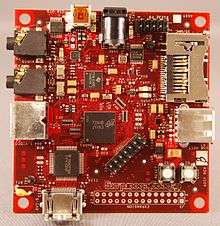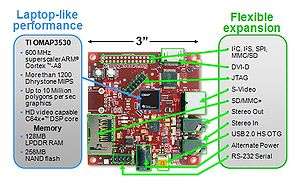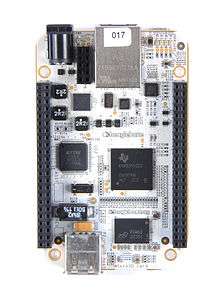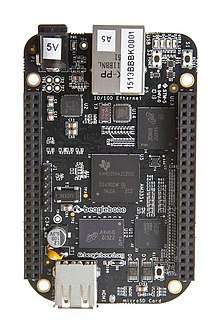BeagleBoard
The BeagleBoard is a low-power open-source single-board computer produced by Texas Instruments in association with Digi-Key and Newark element14. The BeagleBoard was also designed with open source software development in mind, and as a way of demonstrating the Texas Instrument's OMAP3530 system-on-a-chip.[8] The board was developed by a small team of engineers as an educational board that could be used in colleges around the world to teach open source hardware and software capabilities. It is also sold to the public under the Creative Commons share-alike license. The board was designed using Cadence OrCAD for schematics and Cadence Allegro for PCB manufacturing; no simulation software was used.
 BeagleBoard rev.B | |
| Common manufacturers | Circuitco LLC on behalf of BeagleBoard.org |
|---|---|
| Design firm | Texas Instruments |
| Introduced | BeagleBoard July 28, 2008[1] BeagleBoard rev.C May 13, 2009[2] BeagleBoard-xM September 14, 2010[3] BeagleBone October 31, 2011[4] BeagleBone Black April 23, 2013[5] BeagleBoard-X15 November 1, 2015[6] |
| Cost | US$95 to $149 |
| Type | Single-board computer |
| Processor | ARM Cortex-A8 |
| Frequency | 600 MHz to 1 GHz |
| Memory | 128 MB to 512 MB |
| Connection | USB On-The-Go |
| Ports | USB On-The-Go/DVI-D/PC audio/SDHC/JTAG/HDMI |
| Power consumption | 2 W |
| Weight | ~37 g[7] |
| Dimensions | 7.62 cm × 7.62 cm × 1.6 cm |
Features
The BeagleBoard measures approximately 75 by 75 mm and has all the functionality of a basic computer.[9] The OMAP3530 includes an ARM Cortex-A8 CPU (which can run Linux, Minix,[10] FreeBSD,[11] OpenBSD,[12] RISC OS,[13] or Symbian; a number of unofficial Android ports exist[14][15]), a TMS320C64x+ DSP for accelerated video and audio decoding, and an Imagination Technologies PowerVR SGX530 GPU to provide accelerated 2D and 3D rendering that supports OpenGL ES 2.0. Video out is provided through separate S-Video and HDMI connections. A single SD/MMC card slot supporting SDIO, a USB On-The-Go port, an RS-232 serial connection, a JTAG connection, and two stereo 3.5 mm jacks for audio in/out are provided.
Built-in storage and memory are provided through a PoP chip that includes 256 MB of NAND flash memory and 256 MB of RAM (128 MB on earlier models).
The board uses up to 2 W of power and can be powered from the USB connector, or a separate 5 V power supply.
Rev. C4 specifications

- Package on package (PoP) SoC/Memory chip.
- Processor TI OMAP3530 SoC – 720 MHz ARM Cortex-A8 core
- "HD capable" TMS320C64x+ core (520 MHz up to 720p @30 fps)[16]:3
- Imagination Technologies PowerVR SGX 2D/3D graphics processor supporting dual independent displays[9]
- 256 MB LPDDR RAM[16]:3
- 256 MB NAND Flash memory[16]:3
- Peripheral connections[16]:4
- DVI-D (HDMI connector chosen for size – maximum resolution is 1280 × 1024 – and it does not output digital audio)
- S-Video
- USB OTG (mini AB)
- 1 USB port
- SD/MMC card slot
- Stereo in and out jacks
- RS-232 port
- JTAG connector
- Power socket (5 V barrel connector type)
- Development[17]:9
- Boot code stored in ROM
- Boot from NAND memory, SD/MMC, USB, or serial
- Alternative boot source button.
- Has been demonstrated using Android,[18][14][15] Angstrom Linux,[19] Fedora, Ubuntu, Gentoo,[20] Arch Linux ARM,[21] openSUSE for ARM[22] and Maemo Linux distributions,[23] VxWorks,[24] FreeBSD,[11] the Windows CE operating system,[25] Symbian,[26] QNX[27] and a version of RISC OS 5[28] made available by RISC OS Open.
BeagleBoard-xM
Features
A modified version of the BeagleBoard called the BeagleBoard-xM started shipping on August 27, 2010. The BeagleBoard-xM measures in at 82.55 by 82.55 mm and has a faster CPU core (clocked at 1 GHz compared to the 720 MHz of the BeagleBoard), more RAM (512 MB compared to 256 MB), onboard Ethernet jack, and 4 port USB hub. The BeagleBoard-xM lacks the onboard NAND and therefore requires the OS and other data to be stored on a microSD card. The addition of the Camera port to the -xM provides a simple way of importing video via Leopard Board cameras.[29][30]
Specifications
- Package on Package POP CPU/memory chip.
- Processor TI DM3730 Processor – 1 GHz ARM Cortex-A8 core
- 'HD capable' TMS320C64x+ core (800 MHz up to 720p @30 fps)[16]:3
- Imagination Technologies PowerVR SGX 2D/3D graphics processor supporting dual independent displays[9]
- 512 MB LPDDR RAM[16]:3
- 4 GB microSD card supplied with the BeagleBoard-xM and loaded with The Angstrom Distribution
- Peripheral connections[16]:4
- DVI-D (HDMI connector chosen for size – maximum resolution is 1400 x 1050)
- S-Video
- USB OTG (mini AB)
- 4 USB ports
- Ethernet
- MicroSD/MMC card
- Stereo in and out jacks
- RS-232 port
- JTAG connector
- Power socket (5 V barrel connector type)
- Camera port
- Expansion port
- Development[17]:9
BeagleBone

Announced in the end of October 2011, the BeagleBone is a barebone development board with a Sitara ARM Cortex-A8 processor running at 720 MHz, 256 MB of RAM, two 46-pin expansion connectors, on-chip Ethernet, a microSD slot, and a USB host port and multipurpose device port which includes low-level serial control and JTAG hardware debug connections, so no JTAG emulator is required. The BeagleBone was initially priced at US$89.[32]
A number of BeagleBone "Capes" have recently been released. These capes are expansion boards which can be stacked onto the BeagleBone Board (up to four at one time). BeagleBone capes include but are not limited to:
- LCD touchscreen capes (7" and 3.5")
- DVI-D cape
- Breakout cape
- Breadboard cape
- CAN bus cape
- RS-232 cape
- Battery cape[33]
BeagleBone Black

Launched on April 23, 2013 at a price of $45. Among other differences, it increases RAM to 512 MB, the processor clock to 1 GHz, and it adds HDMI and 2 GB of eMMC flash memory. The BeagleBone Black also ships with Linux kernel 3.8, upgraded from the original BeagleBone's Linux kernel 3.2, allowing the BeagleBone Black to take advantage of Direct Rendering Manager (DRM).
BeagleBone Black Revision C (released in 2014) increased the size of the flash memory to 4 GB. This enables it to ship with Debian GNU/Linux installed. Previous revisions shipped with Ångström Linux.[34]
BeagleBoard-X15
The BeagleBoard-X15[35][36] is based on the TI Sitara AM5728 processor with two ARM Cortex-A15 cores running at 1.5 GHz, two ARM Cortex-M4 cores running at 212 MHz and two TI C66x DSP cores running at 700 MHz.[37] The processor provides USB 3.0 support and has a PowerVR dual core SGX544 GPU running at 532 MHz.
PocketBeagle
Launched in September 2017, PocketBeagle offers identical computing performance to BeagleBone Black in a physical form factor that offers over 50% reduction in size and 75% reduction in weight, along with over 40% cheaper purchase price (December 2018 MSRP US$25 vs. US$45 for BeagleBone Black). The miniaturization was made possible by using the Octavo Systems OSD3358-SM that shrinks all major subsystems of the BeagleBone Black into a single ceramic package attached using ball grid array. The advantages of the miniaturization come at the cost of removal of all built-in connectors except for a single micro USB port, the removal of on-board eMMC flash storage, and a reduction of header pins from 92 down to 72 due to space constraints, meaning that most capes will either not work at all or need heavy modifications to work with PocketBeagle. Just as the BeagleBone Black's printed circuit board (PCB) is cut to fit snugly in an Altoids mint tin, PocketBeagle's PCB is cut to fit snugly in an Altoids Smalls mint tin. Recommended use cases for PocketBeagle include embedded devices where size and weight considerations are most critical, such as quadcopter drones and other miniaturized robotics, along with handheld gaming applications.
Specifications
| PocketBeagle | BeagleBoard-X15 | BeagleBone Black | BeagleBone | BeagleBoard-xM | BeagleBoard | ||
|---|---|---|---|---|---|---|---|
| Release Date: | September 21, 2017[38] | 23 September 2016[39] | April 23, 2013 | October 31, 2011 | September 14, 2010 | July 28, 2008 | |
| SoC | OSD3358-SM | Sitara AM5728[40] | AM3358/9 | DM3730 | OMAP3530 | ||
| CPU | Sitara AM3358 ARM Cortex-A8 | Dual ARM Cortex-A15 + Dual ARM M4 (212 MHz) + Quad PRU (200 MHz) | Cortex-A8 + Dual PRU (200 MHz) | ||||
| Frq (MHz) | 1000 | 1500 | 1000 | 720 | 1000 | 720 | |
| GPU | PowerVR SGX530 | Dual PowerVR SGX544 | PowerVR SGX530[41][42][43] (200 MHz) | ||||
| DSP | N/A | Dual TMS320C66x[41] (700 MHz) | N/A | N/A | TMS320C64x+[44] (800 MHz) | TMS320C64x+[41] (520 MHz) | |
| Onboard storage: | 4KB of EEPROM, microSD card slot | 8-bit eMMC 4 GB, microSD card | 8-bit eMMC (Rev B: 2 GB Ångström pre-installed, Rev C: 4 GB Debian pre-installed ), microSD card 3.3 V Supported (No Card Supplied) | microSD card 3.3 V Supported (card supplied with Ångström) | microSD card Supported (card supplied with Ångström) | 256MB NAND Flash, SD/MMC card | |
| Onboard network: | N/A | Dual Gigabit Ethernet | Fast Ethernet (MII based) | Fast Ethernet (MII based) | Fast Ethernet (via USB hub with Ethernet) | N/A | |
| USB ports: | 1 x Micro USB Type B | 3 x USB 3.0 Type A Host 4 x USB 2.0 Host 1 x Micro USB Type B |
1 x Standard A host port (direct). 1x mini B device port (direct) |
1 x Standard A host port (direct). 1x mini B device port (via hub) |
4 x Standard A host port (via hub with Ethernet). 1x mini AB OTG port (direct) |
1 x Standard A host port (direct). 1x mini AB OTG port (direct) | |
| Memory (SDRAM): | 512 MiB DDR3 | 2048 MiB DDR3L | 512 MiB DDR3 | 256 MiB DDR2 | 512 MiB DDR2 | 128 MiB (rev B) DDR 256 MiB (rev C+) DDR | |
| Video outputs: | none | HDMI, LCD via Expansion | Micro-HDMI, cape add-ons | cape add-ons | DVI-D, S-Video | ||
| Audio outputs: | none | HDMI, AIC3104 (Stereo In/Out) | Micro-HDMI, cape add-ons | cape add-ons | 3.5mm audio jack | ||
| Size: | 56mm x 35mm x 5mm | 107 mm × 102 mm (4.2 in × 4.0 in)[45] | 86.40 mm × 53.3 mm (3.402 in × 2.098 in) | ? | 78.74 mm × 76.2 mm (3.1 in × 3.0 in) | ? | |
| Weight: | 10 grams / 0.35 ounces | TBA | 39.68 g (1.400 oz)[46] | ? | ? | ? | |
| Power ratings: | 150 mA @ 5 V | 210–460 mA @5 V | 210–460 mA @5 V | 300–500 mA @5 V | ? | ? | |
| Power source: | micro USB port or I/O pins | 2.5 mm × 5.5 mm 12 V jack | Mini USB or 2.1 mm x 5.5 mm 5 V jack | ||||
| Low-level peripherals: | 3xUART, 4× PWM, 2× SPI, 2× I²C, 2x CAN bus | 7xUART, LCD, GPMC, 1× SPI, 1x I²C, 1x CAN bus | 4xUART, 8× PWM, LCD, GPMC, MMC1, 2× SPI, 2× I²C, A/D Converter, 2× CAN bus, 4 Timers | 4xUART, 8× PWM, LCD, GPMC, MMC1, 2× SPI, 2× I²C, A/D Converter, 2× CAN bus, 4 Timers, FTDI USB to serial, JTAG via USB | McBSP, DSS, I²C, UART, LCD, McSPI, PWM, JTAG, camera interface | McBSP, DSS, I²C, UART, McSPI, PWM, JTAG | |
The following operating systems are reported to have obtained support for the hardware used on the boards: Fedora, Android (code named rowboat), Ubuntu, openSUSE and Ångström. The board also supports other OSes such as FreeBSD, NetBSD, OpenBSD, QNX, MINIX 3, RISC OS, and Windows Embedded.
Optional expansion boards
- BeagleBoard Zippy – Feature expander daughter card for BeagleBoard
- BeagleBoard Zippy2 – Second-generation Zippy. (UART, EEPROM, 100BASE-T, SD-Slot, RTC, I²C (5 V))
- BeagleTouch Display – Touchscreen 4.3" OLED panel with touchscreen, and drivers for Angstrom Linux built by Liquidware.
- BeagleLCD2 Expansion Board – 4.3" wide aspect LCD panel + touchscreen with interface board. Developed by HY Research.
- BeagleJuice – Lithium-ion battery pack for portability developed and built by Liquidware.
- WLAN adapter – This additional expansion card enables wireless connectivity functionality for the BeagleBoard.
- BeadaFrame – 7" TFT LCD display kit includes touch panel and a plastic frame, by NAXING Electronics.
- 4DLCD CAPE – 4.3", 480x272 resolution LCD cape with resistive touch or non-touch and seven push buttons
- Vifff-024 – a very sensitive camera allowing capture of video stream at quarter moon illumination. Developed by ViSensi.org.[47]
Optional enclosures
- Beagle Board RevC Clear Acrylic Case – Case for a BeagleBoard alone. (without Zippy2)
- BeagleLCD2 Clear Acrylic Case – Case for BeagleBoard with BeagleLCD2
Tutorials and Technical Resources
- BBB GPIO interactive map – An interactive map of the GPIO of the BeagleBone Black
- tinkernow.com – DIY website largely based on BeagleBone, resources for setup, operating, and projects.
Clones
- IGEPv2 – a slightly larger board that includes more RAM, built-in Bluetooth and Wi-Fi, a USB host, an Ethernet jack, and use microSD cards instead of regular SD cards.
- ICETEK Mini Board (Chinese)[48]
See also
- Open-source computing hardware
- IOIO
References
- "USB-powered Beagle Board from Digi-Key Unleashes Community Development with Laptop-like Performance and Expansion for $149" (Press release). Digi-Key. July 28, 2008. Archived from the original on October 4, 2011. Retrieved September 15, 2017.
- "Digi-Key Announces New Open Source BeagleBoard Development Board" (Press release). Digi-Key. May 13, 2009. Archived from the original on October 4, 2011. Retrieved September 15, 2017.
- Kridner, Jason (May 4, 2017). "BeagleBoard-xM". BeagleBoard.org. Texas Instruments. Retrieved September 15, 2017.
- "Meet BeagleBone, the new $89 open source hardware platform, giving electronic enthusiasts a smaller, friendlier and more affordable treat" (Press release). BeagleBoard.org. PR Newswire. October 31, 2011. Retrieved September 15, 2017.
- "Digi-Key Continues Support of Innovative Line of TI-based ARM Development Boards from BeagleBoardorg" (Press release). Digi-Key. April 23, 2013. Retrieved September 15, 2017.
- Coley, Gerald (February 24, 2017). "BeagleBoard:BeagleBoard-X15". eLinux. Retrieved September 15, 2017.
- Kridner, Jason (February 5, 2017). "BeagleBoard:Main Page". eLinux. Retrieved September 15, 2017.
- Coley, Gerald (August 20, 2009). "Take advantage of open-source hardware". EDN. Archived from the original on September 15, 2017. Retrieved September 15, 2017.
- "$150 board sports Cortex-A8". LinuxDevices.com. June 9, 2008. Archived from the original on September 1, 2008. Retrieved September 15, 2017.
- lionelsambuc (November 19, 2014). "MINIX 3.3.0 is Available Now". Retrieved September 15, 2017.
Ports are available now for the BeagleBoard XM, BeagleBone white, and BeagleBone black
- dmarion. "creating_bootable_sd_card". People.FreeBSD.org. Retrieved May 5, 2013.
- "armv7". OpenBSD.org. Retrieved July 19, 2013.
- "RISC OS for BeagleBoard". BeagleBoard.org. Texas Instruments. March 27, 2014.
- "BBBAndroid". BeagleBoard.org. Texas Instruments. September 28, 2014. Retrieved September 15, 2017.
- Wmat (November 4, 2013). "BeagleBoard:Android". eLinux. Retrieved September 15, 2017.
- "High performance and numerous expansion options". OMAP3530 BeagleBoard. Digi-Key. May 27, 2009. Archived from the original on May 21, 2010. Retrieved February 4, 2010.
- "Boot Options". OMAP3530 BeagleBoard. Digi-Key. May 27, 2009. Archived from the original on May 21, 2010. Retrieved February 4, 2010.
- "Sitara Android SDK". BeagleBoard.org. Texas Instruments. March 27, 2014. Retrieved September 15, 2017.
- "Linux-friendly Beagle fetches $150". LinuxDevices.com (published July 28, 2008). July 29, 2008. Archived from the original on August 28, 2008.
- "Neuvoo Project". Neuvoo. Neuvoo Devs. Retrieved January 5, 2010.
- "Arch Linux ARM".
- "openSUSE ARM".
- Paul, Ryan (2008-08-01). "TI launches hackable Beagle Board for hobbyist projects". Arstechnica.com. Archived from the original on January 22, 2009. Retrieved 2010-02-04.
- "OMAP3530 Single Board Computer – Beagle Board". Retrieved 2014-06-13.
- "Beagle Board gets Windows CE support". Archived from the original on 2009-04-22.
- "The Wild Ducks Project". wildducks.org. Archived from the original on 2012-07-17. Retrieved 2011-03-31.
- "Foundry27 BSP for BeagleBoard". community.qnx.com. Retrieved 2010-12-03.
- Farrell, Nick (2009-04-27). "Snaps leak of RISC OS5 on Beagleboard". The Inquirer. Retrieved 2011-06-28.
A snap of an RISC OS 5, running on a Beagleboard device powered by a 600 MHz ARM Cortex-A8 processor with a built-in graphics chip, has tipped up on the world wide wibble. The port developed by Jeffrey Lee is a breakthrough for the shared-source project because it has ported the OS without an army of engineers.
- Google Groups. Groups.google.com. Retrieved on 2015-03-25.
- hardware-xM. BeagleBoard.org (2014-11-18). Retrieved on 2015-03-25.
- "SummerOfCode2012/FreeBSDonBeagleBoardxM – FreeBSD Wiki". wiki.freebsd.org.
- $89 dev board includes Cortex-A8 CPU, Ethernet, JTAG Archived 2012-09-11 at Archive.today
- "BeagleBone Capes". Mouser.
- Brown, Eric. "BeagleBone Black doubles flash, embraces Debian". HackerBoards.com. DeviceGuru Blog Network. Archived from the original on 22 October 2016. Retrieved 23 October 2016.
- "BeagleBoard-X15".
- "BeagleBoard-X15 Development Board to feature TI Sitara AM5728 Dual Core Cortex A15 Processor".
- Scheltema, David (October 14, 2015). "BeagleBoard Officially Reveals the X15 — And it's a Beast". Make. Retrieved November 21, 2017.
- Greg Sheridan (September 21, 2017). "PocketBeagle Featuring The OSD335x-SM". octavosystems.com.
- "Beagleboard:BeagleBoard-X15 – eLinux.org". elinux.org.
- "Sitara AM5728 Series" (PDF).
- OMAP3530 | OMAP 3 Processors | OMAP Processors | Description & parametrics. Ti.com (2008-02-25). Retrieved on 2015-03-25.
- AM3359 | AM335x Processors | ARM Cortex-A8 Core | Description & parametrics. Ti.com. Retrieved on 2015-03-25.
- AM3358 | AM335x Processors | ARM Cortex-A8 Core | Description & parametrics. Ti.com. Retrieved on 2015-03-25.
- DM3730 | DM37x Video SOC | ARM Cortex-A8+ Video Core | Description & parametrics. Ti.com. Retrieved on 2015-03-25.
- "BeagleBone X15 Specifications".
- "BeagleBone Black Specifications".
- visensi.org
- "Mini Board". eLinux.org. Retrieved 2010-02-04.
External links
| Wikimedia Commons has media related to BeagleBoard. |